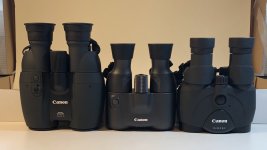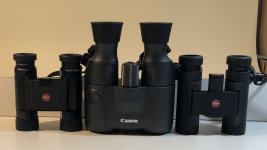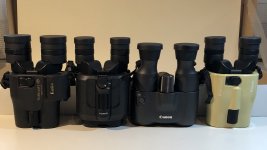First impression: Canon 8x20 IS
When I hear “8x20” in connection with binoculars, I tend to think of pocket devices such as Trinovid 8x20, Ultravid 8x20 or Monovid 8x20.
There has been, and still is, much talk about the benefits of such pocket glasses. Are they "full" binoculars, or are they just auxiliary devices in case you have nothing better with you? Personally, I tend to the second opinion (though I find that an auxiliary device is always better than no device at all). The small exit pupil of 2.5mm and the low weight put limits to the usability, be it regarding image brightness in the twilight or regarding the possibility to keep the glass stable despite muscle tremors. However, pocket glasses have also big advantages: they fit into any jacket pocket and are so light that you can easily carry them around your neck for days.
And here comes Canon with an 8x20 glass that has the disadvantage of the small exit pupil on the one hand, but not the advantage of small size on the other. I was very skeptical when I saw the new 8x20 IS for the first time.
Here are my initial impressions.
Specs:
Magnification: 8x
Objective diameter (effective): 20mm
Exit pupil: 2.5mm
RFOV: 6.6 degrees (= 115m / 1000m)
AFOV: 49.5 degrees
Diopter correction:> +/- 5
Near focus: 2m
Weight (with straps): 459g
The Canon 8x20 IS is as big as an average 8x30 binocular, but very light for the size. Unlike other Canon glasses, the exterior of the binocular body is made of plain gray plastic, without the usual "sticky" coating. The soft rubber eyecups are modeled in “cup shape” like those of the x32 Canons, but they have a much smaller diameter than the those (these have been criticized in this respect) and therefore allow very comfortable use even with narrow IPD. The shape of the 8x20 is similar to the larger 10x32 / 12x32 / 14x32 siblings. Unlike these, it no longer takes two AAA batteries, but one CR2.
The focus is soft, medium-fast and precise; focusing is achieved by movement of the lens block, but there is no cover with a front glass plate like on the x32's (which makes the latter splash-proof). However, the mechanism is still different than in the older 10x30 and 12x36 models, where sometimes dust etc. could be "sucked in" while focusing, Canon seems to have come up with a new solution which, while certainly not waterproof, may be a relatively good on dust (??). To be clarified.
The vibration detection takes place by means of a "Gyrosensor", image stabilization is achieved, as with all newer Canon glasses, by "Lensshift". When you press the button, the image stabilizes immedieately and without any“ jumps" of the image. The image stability seems excellent to me, and the picture retains its sharpness without the "artifacts” that were observed in the older Canons.
The picture quality is Canon-typical high: very good center-sharpness, good edge sharpness, little to no CA in the center, a little bit of CA further out towards the edge, limited reflections on or around bright light sources. More field of view would be nice, of course, but the present one is quite decent.
The ease of view without glasses is very good, but also with glasses I can see the full field of view when the eyecup is folded down.
Short comparison with other 8x20s:
Compared with the Leica Trinovid 8x20, the picture of the Canon 8x20 (even without switching on the IS) seems definitely brighter and more contrasty to me. Compared with the Ultravid 8x20, the matter is less clear, the Ultravid showed about the same brightness and sharpness in the gloomy November weather as the Canon. However, ease of view is better in the Canon, and when the stabilization is turned on, the Canon clearly "wins" in the detail recognition anyway.
Short comparison with compact IS binoculars from other brands:
I can make it short. Of the models available to me - Fujinon Techno-Stabi 12x28, Vixen Atera H 12x30, Kenko 10x30 IS - none comes even close to the Canon, neither in terms of image quality nor image stabilization (although they are all much more expensive than the Canon). A direct comparison would not have worked anyway, since the other models all have 10x or 12x magnification, but a comparison is unnecessary anyway, the pictures of all (and I mean that!) except the Canon appear as dark, blurred and with low contrast to me, resulting somewhere between “unsatisfactory” to “unusable”, and I also find the strong "image bumps" annoying which occur when switching IS on, switching IS off, or during both processes. In addition, only the IS function of the Canon is really capable to cope with my muscle tremors, the image in the others wiggle considerably even with IS on.
Kite Optics is currently introducing a new stabilized binocular into the market, which might be better than Fuji, Vixen and Kenko (it can hardly be worse ;-) …) To be seen.
So far, I am pretty impressed with the Canon 8x20 IS. Then next thing I plan is a proper field test with the Canon. This should reveal whether a 8x20 binocular that is the size of a 8x30 or 8x40, but has the small exit pupil of a pocket binocular, really makes sense.
fwiw Canip
When I hear “8x20” in connection with binoculars, I tend to think of pocket devices such as Trinovid 8x20, Ultravid 8x20 or Monovid 8x20.
There has been, and still is, much talk about the benefits of such pocket glasses. Are they "full" binoculars, or are they just auxiliary devices in case you have nothing better with you? Personally, I tend to the second opinion (though I find that an auxiliary device is always better than no device at all). The small exit pupil of 2.5mm and the low weight put limits to the usability, be it regarding image brightness in the twilight or regarding the possibility to keep the glass stable despite muscle tremors. However, pocket glasses have also big advantages: they fit into any jacket pocket and are so light that you can easily carry them around your neck for days.
And here comes Canon with an 8x20 glass that has the disadvantage of the small exit pupil on the one hand, but not the advantage of small size on the other. I was very skeptical when I saw the new 8x20 IS for the first time.
Here are my initial impressions.
Specs:
Magnification: 8x
Objective diameter (effective): 20mm
Exit pupil: 2.5mm
RFOV: 6.6 degrees (= 115m / 1000m)
AFOV: 49.5 degrees
Diopter correction:> +/- 5
Near focus: 2m
Weight (with straps): 459g
The Canon 8x20 IS is as big as an average 8x30 binocular, but very light for the size. Unlike other Canon glasses, the exterior of the binocular body is made of plain gray plastic, without the usual "sticky" coating. The soft rubber eyecups are modeled in “cup shape” like those of the x32 Canons, but they have a much smaller diameter than the those (these have been criticized in this respect) and therefore allow very comfortable use even with narrow IPD. The shape of the 8x20 is similar to the larger 10x32 / 12x32 / 14x32 siblings. Unlike these, it no longer takes two AAA batteries, but one CR2.
The focus is soft, medium-fast and precise; focusing is achieved by movement of the lens block, but there is no cover with a front glass plate like on the x32's (which makes the latter splash-proof). However, the mechanism is still different than in the older 10x30 and 12x36 models, where sometimes dust etc. could be "sucked in" while focusing, Canon seems to have come up with a new solution which, while certainly not waterproof, may be a relatively good on dust (??). To be clarified.
The vibration detection takes place by means of a "Gyrosensor", image stabilization is achieved, as with all newer Canon glasses, by "Lensshift". When you press the button, the image stabilizes immedieately and without any“ jumps" of the image. The image stability seems excellent to me, and the picture retains its sharpness without the "artifacts” that were observed in the older Canons.
The picture quality is Canon-typical high: very good center-sharpness, good edge sharpness, little to no CA in the center, a little bit of CA further out towards the edge, limited reflections on or around bright light sources. More field of view would be nice, of course, but the present one is quite decent.
The ease of view without glasses is very good, but also with glasses I can see the full field of view when the eyecup is folded down.
Short comparison with other 8x20s:
Compared with the Leica Trinovid 8x20, the picture of the Canon 8x20 (even without switching on the IS) seems definitely brighter and more contrasty to me. Compared with the Ultravid 8x20, the matter is less clear, the Ultravid showed about the same brightness and sharpness in the gloomy November weather as the Canon. However, ease of view is better in the Canon, and when the stabilization is turned on, the Canon clearly "wins" in the detail recognition anyway.
Short comparison with compact IS binoculars from other brands:
I can make it short. Of the models available to me - Fujinon Techno-Stabi 12x28, Vixen Atera H 12x30, Kenko 10x30 IS - none comes even close to the Canon, neither in terms of image quality nor image stabilization (although they are all much more expensive than the Canon). A direct comparison would not have worked anyway, since the other models all have 10x or 12x magnification, but a comparison is unnecessary anyway, the pictures of all (and I mean that!) except the Canon appear as dark, blurred and with low contrast to me, resulting somewhere between “unsatisfactory” to “unusable”, and I also find the strong "image bumps" annoying which occur when switching IS on, switching IS off, or during both processes. In addition, only the IS function of the Canon is really capable to cope with my muscle tremors, the image in the others wiggle considerably even with IS on.
Kite Optics is currently introducing a new stabilized binocular into the market, which might be better than Fuji, Vixen and Kenko (it can hardly be worse ;-) …) To be seen.
So far, I am pretty impressed with the Canon 8x20 IS. Then next thing I plan is a proper field test with the Canon. This should reveal whether a 8x20 binocular that is the size of a 8x30 or 8x40, but has the small exit pupil of a pocket binocular, really makes sense.
fwiw Canip







